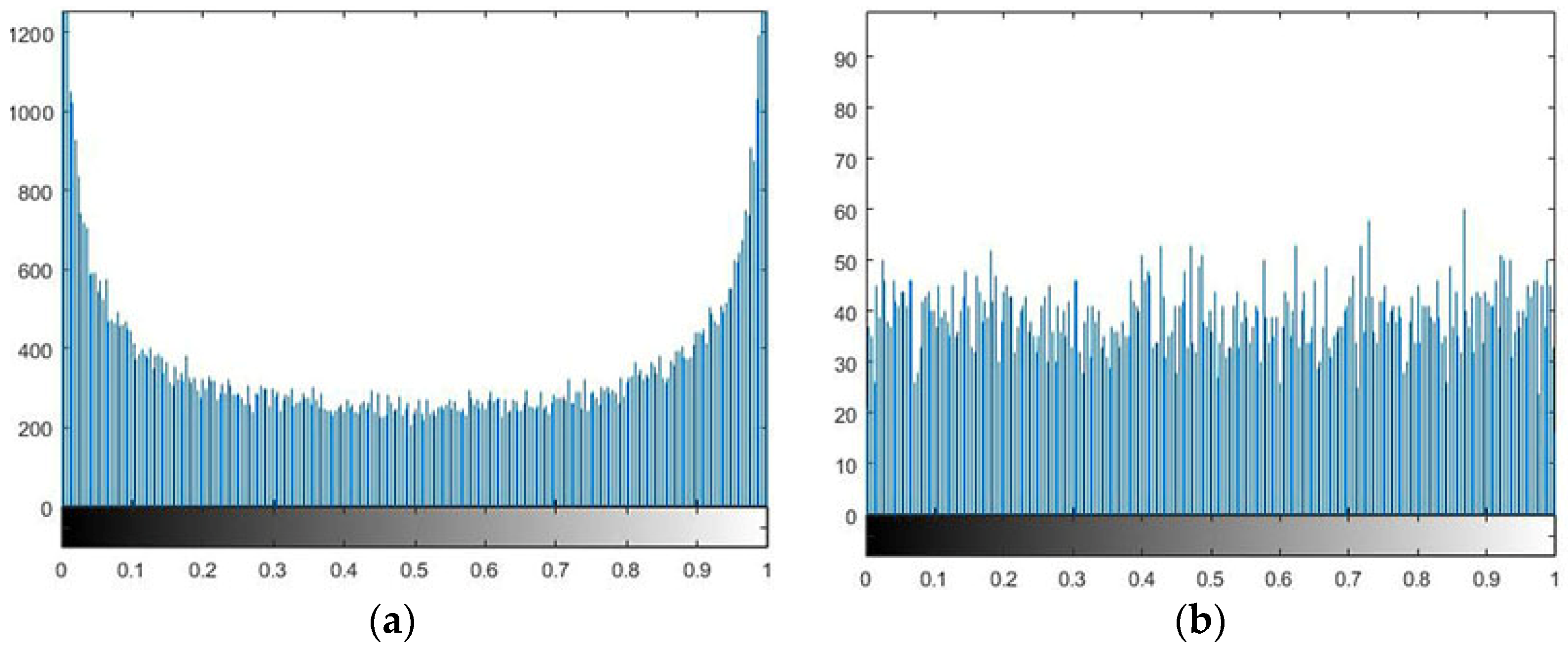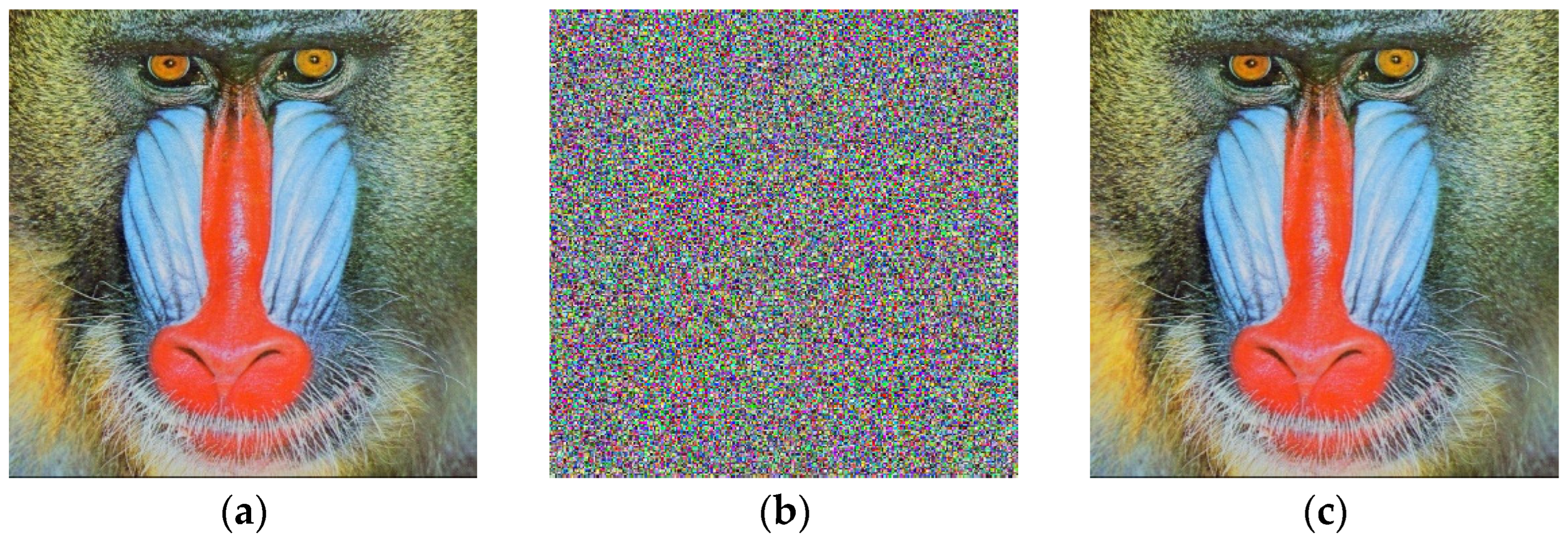A Novel Color Image Encryption Algorithm Using Coupled Map Lattice with Polymorphic Mapping
Abstract
:1. Introduction
2. Polymorphic Spatiotemporal Chaotic Systems and Random Ergodicity
2.1. Extension of T Diffusion Matrix
2.2. Polymorphic CML
2.3. Use of the Probability Replacement of the Pixel Value
3. Image Encryption Algorithm Based on CML with Polymorphic Mapping
3.1. Key Generation
3.2. Encryption Algorithm Process
3.3. Decryption Process of Algorithm
4. Experimental Results
5. Security Analysis
5.1. Key-Space Analysis
5.2. Statistical Analysis
5.2.1. Histogram Analysis
5.2.2. Adjacent Pixel Correlation
5.2.3. Information Entropy
5.2.4. Resistance to Differential Attacks
5.2.5. Robustness Analysis
5.2.6. Sensitivity Analysis
5.2.7. Complexity Analysis
6. Conclusions
Author Contributions
Funding
Informed Consent Statement
Conflicts of Interest
References
- Stinson, D. Cryptography: Theory and Practice, 2nd ed.; CRC Press Public House of Electronic Industry: Boca Raton, FL, USA, 2002. [Google Scholar]
- Long, S. A comparative analysis of the application of hashing encryption algorithms for MD5, SHA-1, and SHA-512. J. Phys. Conf. Ser. 2019, 1314, 012210. [Google Scholar] [CrossRef]
- Wang X, Y.; Zhang, H.L. A novel image encryption algorithm based on genetic recombination and hyper-chaotic systems. Nonlinear Dyn. 2016, 83, 333–346. [Google Scholar] [CrossRef]
- Wang, X.; Zhang, M. An image encryption algorithm based on new chaos and diffusion values of a truth table. Inf. Sci. 2021, 579, 128–149. [Google Scholar] [CrossRef]
- Li, Z.; Peng, C.; Tan, W.; Li, L. A novel chaos-based color image encryption scheme using bit-level permutation. Symmetry 2020, 12, 1497. [Google Scholar] [CrossRef]
- Zarebnia, M.; Parvaz, R. Image encryption algorithm by fractional based chaotic system and framelet transform. Chaos Solitons Fractals 2021, 152, 111402. [Google Scholar] [CrossRef]
- Wu, D.; Wu, C. Research on the time-dependent split delivery green vehicle routing problem for fresh agricultural products with multiple time windows. Agriculture 2022, 12, 793. [Google Scholar] [CrossRef]
- Li, X.; Zhao, H.; Yu, L.; Chen, H.; Deng, W.; Deng, W. Feature extraction using parameterized multisynchrosqueezing transform. IEEE Sens. J. 2022, 2, 14263–14272. [Google Scholar] [CrossRef]
- Zhou, X.B.; Ma, H.J.; Gu, J.G.; Chen, H.L.; Deng, W. Parameter adaptation-based ant colony optimization with dynamic hybrid mechanism. Eng. Appl. Artif. Intell. 2022, 114, 105139. [Google Scholar] [CrossRef]
- Li, T.Y.; Shi, J.Y.; Deng, W.; Hu, Z.D. Pyramid particle swarm optimization with novel strategies of competition and cooperation. Appl. Soft Comput. 2022, 121, 108731. [Google Scholar] [CrossRef]
- Chen, H.Y.; Miao, F.; Chen, Y.J.; Xiong, Y.J.; Chen, T. A hyperspectral image classification method using multifeature vectors and optimized KELM. IEEE J. Sel. Top. Appl. Earth Obs. Remote Sens. 2021, 14, 2781–2795. [Google Scholar] [CrossRef]
- Yao, R.; Guo, C.; Deng, W.; Zhao, H.M. A novel mathematical morphology spectrum entropy based on scale-adaptive techniques. ISA Trans. 2022, 126, 691–702. [Google Scholar] [CrossRef] [PubMed]
- Zhao, H.M.; Liu, J.; Chen, H.Y.; Chen, J.; Li, Y.; Xu, J.J.; Deng, W. Intelligent diagnosis using continuous wavelet transform and gauss convolutional deep belief network. IEEE Trans. Reliab. 2022, 1–11. [Google Scholar] [CrossRef]
- Wei, Y.Y.; Zhou, Y.Q.; Luo, Q.F.; Deng, W. Optimal reactive power dispatch using an improved slime Mould algorithm. Energy Rep. 2021, 7, 8742–8759. [Google Scholar] [CrossRef]
- Deng, W.; Ni, H.C.; Liu, Y.; Chen, H.L.; Zhao, H.M. An adaptive differential evolution algorithm based on belief space and generalized opposition-based learning for resource allocation. Appl. Soft Comput. 2022, 127, 109419. [Google Scholar] [CrossRef]
- Chen, H.Y.; Fang, M.; Xu, S. Hyperspectral remote sensing image classification with CNN based on quantum genetic-optimized sparse representation. IEEE ACCESS 2020, 8, 99900–99909. [Google Scholar] [CrossRef]
- Deng, W.; Zhang, L.; Zhou, X.; Zhou, Y.; Sun, Y.; Zhu, W.; Chen, H.; Deng, W.; Chen, H.; Zhao, H. Multi-strategy particle swarm and ant colony hybrid optimization for airport taxiway planning problem. Inf. Sci. 2022, 612, 576–593. [Google Scholar] [CrossRef]
- Song, Y.; Cai, X.; Zhou, X.; Zhang, B.; Chen, H.; Li, Y.; Deng, W.; Deng, W. Dynamic hybrid mechanism-based differential evolution algorithm and its application. Expert Syst. Appl. 2023, 213, 118834. [Google Scholar] [CrossRef]
- Zhang, Z.; Huang, W.G.; Liao, Y.; Song, Z.; Shi, J.; Jiang, X.; Shen, C.; Zhu, Z. Bearing fault diagnosis via generalized logarithm sparse regularization. Mech. Syst. Signal Process. 2022, 167, 108576. [Google Scholar] [CrossRef]
- Li, N.; Huang, W.G.; Guo, W.J.; Gao, G.Q.; Zhu, Z. Multiple enhanced sparse decomposition for gearbox compound fault diagnosis. IEEE Trans. Instrum. Meas. 2020, 69, 770–781. [Google Scholar] [CrossRef]
- Xu, G.; Bai, H.; Xing, J.; Luo, T.; Xiong, N.N. SG-PBFT: A secure and highly efficient distributed blockchain PBFT consensus algorithm for intelligent Internet of vehicles. J. Parallel Distrib. Comput. 2022, 164, 1–11. [Google Scholar] [CrossRef]
- Zheng, J.J.; Yuan, Y.; Zou, L.; Deng, W.; Guo, C.; Zhao, H. Study on a novel fault diagnosis method based on VMD and BLM. Symmetry 2019, 11, 747. [Google Scholar] [CrossRef] [Green Version]
- Wu, X.; Wang, Z.C.; Wu, T.H.; Bao, X.G. Solving the family traveling salesperson problem in the adleman–lipton model based on DNA computing. IEEE Trans. NanoBioscience 2021, 21, 75–85. [Google Scholar] [CrossRef] [PubMed]
- Cao, H.; Shao, H.; Zhong, X.; Deng, Q.; Yang, X.; Xuan, J. Unsupervised domain-share CNN for machine fault transfer diagnosis from steady speeds to time-varying speeds. J. Manuf. Syst. 2022, 62, 186–198. [Google Scholar] [CrossRef]
- Zhou, Y.; Zhang, J.; Yang, X.; Ling, Y. Optimal reactive power dispatch using water wave optimization algorithm. Oper. Res. 2020, 20, 2537–2553. [Google Scholar] [CrossRef]
- Xu, G.; Dong, W.; Xing, J.; Lei, W.; Liu, J. Delay-CJ: A novel cryptojacking covert attack method based on delayed strategy and its detection. Digit. Commun. Netw. 2022; in press. [Google Scholar] [CrossRef]
- Li, X.; Shao, H.; Lu, S.; Xiang, J.; Cai, B. Highly-efficient fault diagnosis of rotating machinery under time-varying speeds using LSISMM and small infrared thermal images. IEEE Trans. Syst. Man Cybern. Syst. 2022, 30, 135–142. [Google Scholar] [CrossRef]
- Ren, Z.; Han, X.; Yu, X.; Skjetne, R.; Johan, B.; Leira, S.; Zhu, M. Data-driven simultaneous identification of the 6DOF dynamic model and wave load for a ship in waves. Mech. Syst. Signal Process. 2023, 184, 109422. [Google Scholar] [CrossRef]
- Roellgen, C.B. Polymorphic cipher theory. 2004. Available online: http://www.ciphers.de/products/polymorphic_cipher_theory.html (accessed on 12 September 2022).
- Mackowski, D.W.; Mishchenko, M.I. Calculation of the T matrix and the scattering matrix for ensembles of spheres. J. Opt. Soc. Am. A 1996, 13, 2266–2278. [Google Scholar] [CrossRef]
- Behnia, S.; Akhshani, A.; Mahmodi, H.; Akhavan, A.J.C.S. A novel algorithm for image encryption based on mixture of chaotic maps. Chaos soliton& fract. 2008, 35, 408–419. [Google Scholar]
- Hussain, I.; Shah, T.; Gondal, M.A. Image encryption algorithm based on PGL(2,GF(28)) S-boxes and TD-ERCS chaotic sequence. Nonlinear Dynam. 2012, 70, 181–187. [Google Scholar] [CrossRef]
- Hussain, I.; Shah, T.; Gondal, M.A. An efficient image encryption algorithm based on S8 S-box transformation and NCA map. Opt. Commun. 2012, 285, 4887–4890. [Google Scholar] [CrossRef]
- Zhu, Z.L.; Zhang, W.; Wong, K.W.; Yu, H. A chaos-based symmetric image encryption scheme using a bit-level permutation. Inf. Sci. Int. J. 2011, 181, 1171–1186. [Google Scholar] [CrossRef]
- Hussain, I.; Gondal, M.A. An extended image encryption using chaotic coupled map and S-box transformation. Nonlinear Dynam. 2014, 76, 1355–1363. [Google Scholar] [CrossRef]
- Baptista, M.S. Cryptography with chaos. Phys. Lett. A 1998, 240, 50–54. [Google Scholar] [CrossRef]
- Jain, A.; Rajpal, N. A robust image encryption algorithm resistant to attacks using DNA and chaotic logistic maps. Multimed. Tools Appl. 2016, 75, 5455–5472. [Google Scholar] [CrossRef]
- Rehman, A.U.; Liao, X.; Kulsoom, A.; Abbas, S. Selective encryption for gray images based on chaos and DNA complementary rules. Multimed. Tools Appl. 2015, 74, 4655–4677. [Google Scholar] [CrossRef]
- Huang, X.; Ye, G. An image encryption algorithm based on hyper-chaos and DNA sequence. Multimed. Tools Appl. 2014, 72, 57–70. [Google Scholar] [CrossRef]
- Bakhshandeh, A.; Eslami, Z. An authenticated image encryption scheme based on chaotic maps and memory cellular automata. Opt. Lasers Eng. 2013, 51, 665–673. [Google Scholar] [CrossRef]
- Xu, L.; Li, Z.; Li, J.; Hua, W. A novel bit-level image encryption algorithm based on chaotic maps. Opt. Lasers Eng. 2016, 78, 17–25. [Google Scholar] [CrossRef]
- Zhang, Q.; Guo, L.; Wei, X. Image encryption using DNA addition combining with chaotic maps. Math. Comput. Model. 2010, 52, 2028–2035. [Google Scholar] [CrossRef]
- Liu, H.; Wang, X.Y.; Kadir, A. Image encryption using DNA complementary rule and chaotic maps. Appl. Soft Comput. 2012, 12, 1457–1466. [Google Scholar] [CrossRef]
- Rhouma, R.; Belghith, S. Cryptanalysis of a spatiotemporal chaotic image/video cryptosystem. Phys. Lett. A 2008, 372, 5790–5794. [Google Scholar] [CrossRef]
- Akhshani, A.; Behnia, S.; Akhavan, A.; AbuHassana, H.; Hassana, H. A novel scheme for image encryption based on 2D piecewise chaotic maps. Opt. Commun. 2010, 283, 3259–3266. [Google Scholar] [CrossRef]
- Hussain, I.; Shah, T.; Gondal, M.A. Image encryption algorithm based on total shuffling scheme and chaotic S-box transformation. J. Vib. Control. 2014, 20, 2133–2136. [Google Scholar] [CrossRef]
- Nematzadeh, H.; Enayatifar, R.; Motameni, H. Medical image encryption using a hybrid model of modified genetic algorithm and coupled map lattices. Opt. Lasers Eng. 2018, 110, 24–32. [Google Scholar] [CrossRef]













| Parameter Range | |
|---|---|
| Lena | Plaintext | Ciphertext | ||||
|---|---|---|---|---|---|---|
| R | G | B | R | G | B | |
| Horizontal | 0.988 | 0.983 | 0.955 | 0.002 | 0.009 | 0.001 |
| Vertical | 0.974 | 0.951 | 0.935 | 0.032 | −0.002 | 0.052 |
| Diagonal | 0.974 | 0.950 | 0.921 | 0.002 | 0.019 | 0.025 |
Publisher’s Note: MDPI stays neutral with regard to jurisdictional claims in published maps and institutional affiliations. |
© 2022 by the authors. Licensee MDPI, Basel, Switzerland. This article is an open access article distributed under the terms and conditions of the Creative Commons Attribution (CC BY) license (https://creativecommons.org/licenses/by/4.0/).
Share and Cite
Huang, P.; Li, D.; Wang, Y.; Zhao, H.; Deng, W. A Novel Color Image Encryption Algorithm Using Coupled Map Lattice with Polymorphic Mapping. Electronics 2022, 11, 3436. https://doi.org/10.3390/electronics11213436
Huang P, Li D, Wang Y, Zhao H, Deng W. A Novel Color Image Encryption Algorithm Using Coupled Map Lattice with Polymorphic Mapping. Electronics. 2022; 11(21):3436. https://doi.org/10.3390/electronics11213436
Chicago/Turabian StyleHuang, Penghe, Dongyan Li, Yu Wang, Huimin Zhao, and Wu Deng. 2022. "A Novel Color Image Encryption Algorithm Using Coupled Map Lattice with Polymorphic Mapping" Electronics 11, no. 21: 3436. https://doi.org/10.3390/electronics11213436
APA StyleHuang, P., Li, D., Wang, Y., Zhao, H., & Deng, W. (2022). A Novel Color Image Encryption Algorithm Using Coupled Map Lattice with Polymorphic Mapping. Electronics, 11(21), 3436. https://doi.org/10.3390/electronics11213436







